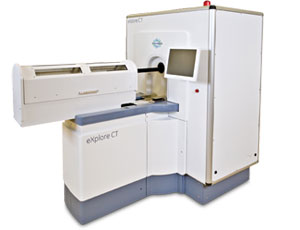| PreClinical |
|
Preclinical Imaging
Preclinical imaging¬†is the visualization of living animals for research purposes,¬†such as drug development. Imaging modalities have long been crucial to the researcher in observing¬†changes, either at the organ, tissue, cell, or molecular level, in animals responding to physiological or environmental changes. Imaging modalities that are non-invasive and¬†in vivo¬†have¬†become especially important to study animal models longitudinally. Broadly speaking, these imaging systems can be categorized into primarily morphological/anatomical and primarily¬†molecular imaging techniques.¬†Techniques such as¬†high-frequency micro-ultrasound,¬†magnetic resonance imaging¬†(MRI) and¬†computed tomography¬†(CT) are usually used for anatomical¬†imaging, while optical imaging (fluorescence¬†and¬†bioluminescence),¬†positron emission tomography¬†(PET), and¬†single photon emission computed tomography¬†(SPECT) are usually used for¬†molecular visualizations. Gamma Medica is the first company to have developed and made commercially available a trimodality system. The Triumph‚ĄĘ System is a multi-modality pre-clinical imaging platform offering multiple configurations to meet your needs.
Gamma Medica Pre-Clinical Imaging Division products, click on the following:
  European Service Contact:  This e-mail address is being protected from spambots. You need JavaScript enabled to view it |







 PreClinical
PreClinical




